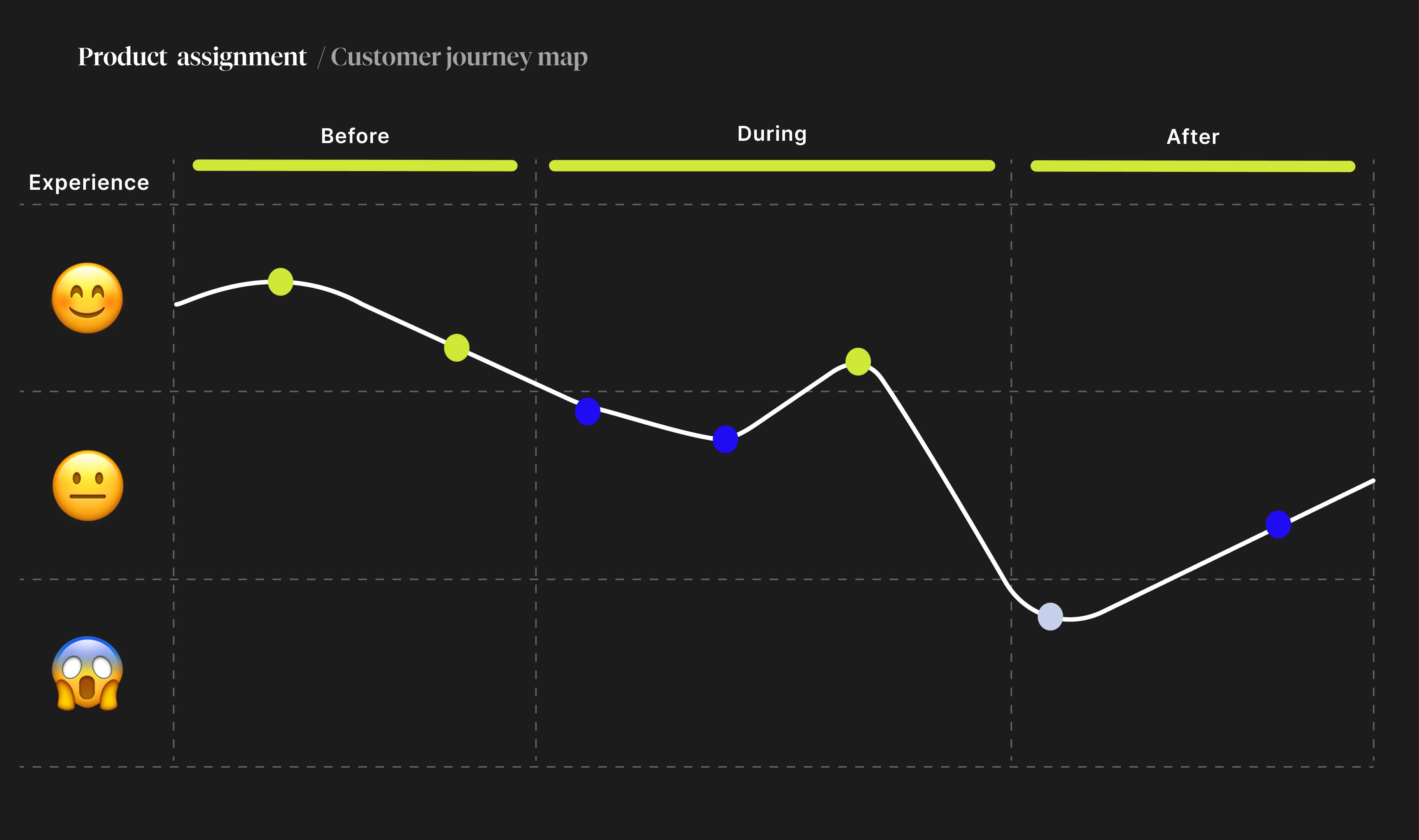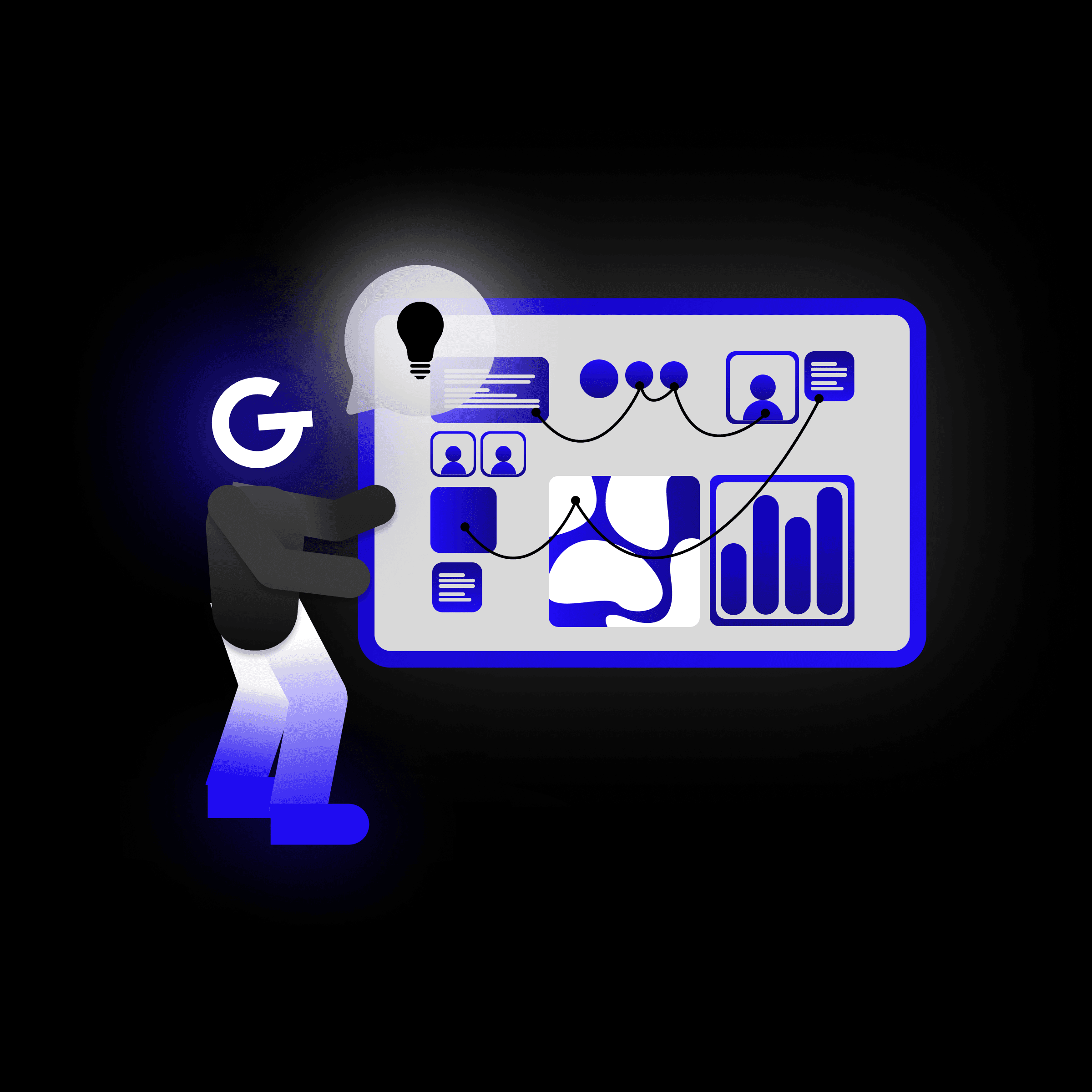
12. Sep 2024Business
How to write a good product assignment 2 - assignment extensions and bonus sections
Today, we'll introduce you to two additional tools you can use as a team in the digital product creation process. However, they are also great for improving existing services or products.


Before we dive into today's content, we want to remind you that a good assignment defines the success of the entire project. That's why in a recent article, we've prepared a comprehensive guide and free downloadable template for commissioning a digital product. Be sure not to overlook this article so that you have all the information you need.
Must-have sections without which the assignment is not an assignment can be found here 👇

Parts of this article are not necessary, but they will help. They will expand the assignment with valuable information or help you as a team go more in-depth, minimize risk, and maximize your investment in the product.
Have a pleasant reading!
Customer journey mapping
- How does a customer get to your product?
- Where will you reach them and what will gain their interest?
- Who or what will they interact with before they start using your product?
- How do they travel across your product?
- And then what happens when they do what they need to do?
A customer journey map provides the answers to these questions.
Did you know that 80% of customers say the experience a company provides is as important as its products and services.
The customer journey is the type of activity you'll instantly love. It's a simple but effective tool. It forces you to empathize, allows you to put yourself in your customers' shoes, and imagine what they go through from the point where they feel the need or problem that your service solves to the point where they leave your store, website, or app satisfied.

Organize a workshop
Who to invite?
Certainly, the presence of the product or service owner is required. You also need to invite the people who are most often in contact with your customers. Often, this is someone from the support team and sales team. The ideal group is 4 people: Product Owner/CEO, support person, sales person, and marketing person.
Oh, and of course, there must be a facilitator.
The facilitator must not be involved in the content itself. They should listen well, have good critical thinking, guide the process, and ask follow-up questions. A good facilitator is not satisfied with an answer that goes over the surface but inquires further. It is the good facilitator who often holds the quality of the customer journey itself.
If you don't have such a person in your company, we can tailor-make such a workshop for you here at GoodRequest.
How much time to reserve?
Usually, 2–3 hours are enough. If you're all going to be in person, prepare post-its, a large whiteboard, markers, and refreshments. If you're planning an online format, tools like FigJam or Miro will serve you well.

How to do it?
There are three ways to complete the customer journey:
- If you have an established product and know your customers well, use real insights and data you have about them. These are the people who are often in contact with customers and know the most about them. You can also look at data from the use of the site or app.
- If you're launching a new product or service, it's normal to have more questions than answers. That's when it's a good idea to do at least a few interviews with your potential customers to get to know how they operate, what they struggle with, and what their needs are. The outputs will serve as valuable input for the customer journey.
- If you don't even have interviews, try to put yourself in your customers' shoes and answer individual questions honestly. Can't see inside their heads and think it won't be accurate? It doesn't matter. You have to start somewhere. Work with the understanding that these are your hypotheses and need to be validated.
The customer journey is a living tool that is constantly being updated. If you work with it regularly, it can serve well as a tool for managing an entire product, service, or even an entire company.

Let's do it!
Open the template, which can be found at the end of the article, and follow it from left to right, column by column. For each column, define the following:
- Touchpoints – The points of interaction that the customer experiences.
- Behind the Scenes – The processes and activities happening in the company that support each touchpoint.
- Evaluation – How the customer feels and evaluates each stage.
- Opportunities – What can be improved at this stage.
Start with what happens before the customer comes into contact with you.
Before the purchase
- What does the customer do when they feel a need or problem?
- What goes through their mind? What are their concerns?
- What are they looking for? Where are they looking? Who are they talking to?
- What options do they have? What parameters are they comparing?
- Where do they come across you? On what communication channel? What do they learn?
During the buying process
The customer already knows about you. What happens next?
- What points of interaction might they have with you? Break them all down in detail.
- Who are they talking to? What information or offers do they receive?
- What problems are they experiencing? How are you helping them solve those problems?
After the purchase
- What happens once the customer’s need is fulfilled?
- How do you continue working with them?
- How do you ensure they return?
- How do you encourage them to recommend you to others?
What's next?
Throughout the process, you've probably made lots of notes and tasks about what can be improved. The evaluation column will reveal weaker areas in your customer journey, helping you know what to focus on next.
However, the customer journey is a living document. When a product is rolled out, the journey needs to be updated regularly with real data. It can then continue to offer action steps and initiatives to inform your product strategy and business direction.
Exercise on assumptions
The success of a digital product is usually built on hypotheses, or assumptions. It stands and falls on whether or not our hypotheses are confirmed. Those that matter most or pose the greatest risk to success are therefore the ones we seek to validate, ideally before development. We can also call this risk management.
💡 The worst way to validate your hypotheses and assumptions is to build working software.
This exercise is inspired by IDEO's approach. It consists in trying to identify the most critical assumptions/hypotheses, from the perspective of your customers, your team and company, and your competitors or the market.
When to do this?
Ideally before the development of a new product or service begins. But risk identification and risk management should be present in every project. If you don't already work with risks, this is a very good exercise to get started.
Workshop or independent work?
You can either take the exercise as a joint workshop or as independent work and then reconcile with colleagues at a joint meeting to go through what worked for you all. Some people prefer quiet and plenty of time for this type of reflection and so the independent work form may be more effective.
The important thing is to let go of fantasies and move into the future.
In this exercise it is not important what is true today but what should be true in the future.
A workshop can take about 3–4 hours but I have seen cases where we had to split the exercise into 3 separate workshops of 3 hours each.
Invite the stakeholders involved in the topic. The lineup for a new digital product might look like: product owner, marketer, shopper, customer support or someone for operations. The ideal number for a workshop is up to 5 people.
How to do it?
The process has 3 steps. Identifying assumptions, selecting risk assumptions and designing validation tests. We have prepared the whole process in the form of a FigJam template for you to download at the end of the article.
Step 1 - What must be true?
The first step asks, "What must be true for a product to be successful?" We ask this question from the perspective of your customers, your company and product team, as well as your competitors.
What needs to be true about your customers?
- How do they behave? What attitudes should they hold?
- What should your potential customers need? What would they be willing to pay for? And how much?
- What needs to happen for them to switch from your competitors to you?
- What needs to be true about price to make it profitable?
- How should your customer segments evolve?
- What else must be true about your customers?
What must be true about your company and product team?
- What does your team or company need to look like? What kind of people do you need?
- What skills should they have?
- What must be true about your suppliers? What should they be like? What must they not be?
- What technology tools, processes, data or methods do you need?
- About the resources you need?
What must be true about your competition?
- What is your competitors' position in the marketplace?
- How will individual competitors behave?
- How will indirect competitors or similar industries behave?
- How should competitors react to your entry into the market and to your strategy?
- What needs to be true about potential new competitors whose entry into the market could threaten you in the future?
- Be specific but not precise. Use specific numbers but at this stage the point is not to be completely accurate. You will fine tune that later.
- Focus on what really needs to be true. Not on what you would like to be true or what is true today. What matters is the future.
Step 2 - Identify the barriers
In the second step, you go through all the assumptions you've generated and select the ones you most doubt will come true. These are your barriers.
Read the assumptions and ask:
- Which ones are you most worried won't come true?
- Which ones do you have the least information about?
- Can you insure one assumption, which would it be?
Be careful – a barrier is not a critical assumption. You may come across a hypothesis without which the product could not be successful. But it doesn't have to be a barrier as long as you believe it can come true. A barrier is the assumption you most doubt will be true.
Step 3 - Design validation tests
In this step, you will think about how you might test or validate the barriers.
If possible, try to arrange the barriers into groups so that you can validate multiple barriers with one test. Then select an appropriate method to test. Examples of the most common validation methods include:
- interviews with customers or potential customers
- market research
- prototype or concept testing with customers
- price sensitivity research
- interviews with experts and consultants
- interviews or shadowing of internal staff
- mystery shopping
- quantitative research by questionnaire
- analysis of market or internal data
- secondary research and many others
The choice of method depends on the level of risk you can take as well as the cost you are going to invest. The higher the investment the more accurately you should verify the barriers. The choice of the method and the validation itself may already require more professional help from a researcher.
However, this investment is certainly worth it given the cost of software development. You can thus fundamentally minimize the risks.

Get the Tools to Map the Customer Journey and Practice on Assumptions
Whether you're looking to improve the customer experience or minimize risks when creating digital products, these tools are sure to come in handy. We've put together templates that you can download absolutely free.
If you have any questions while filling them out, don't hesitate to contact us. We wish you a pleasant and productive thinking about your project!

Related articles

How to build AI solutions that deliver 10× more value for your business


Importance of analysts in successful software projects


How we approach estimations
